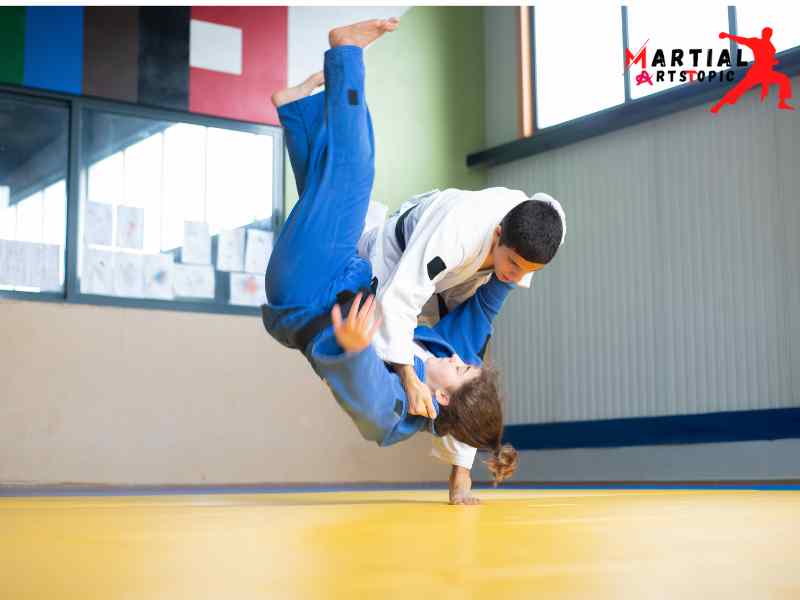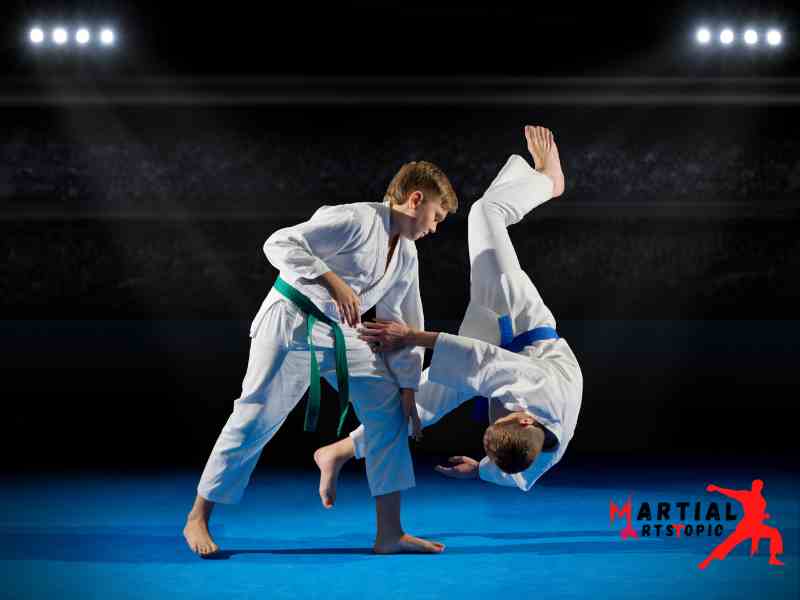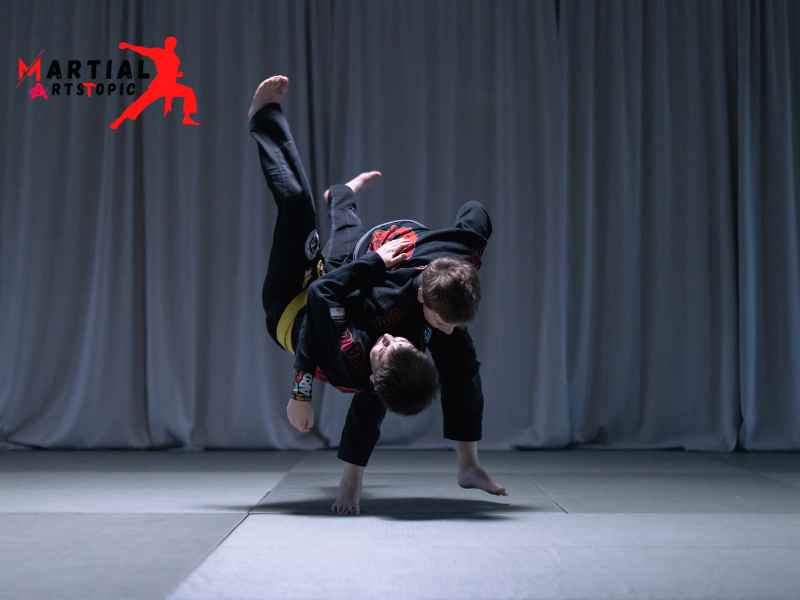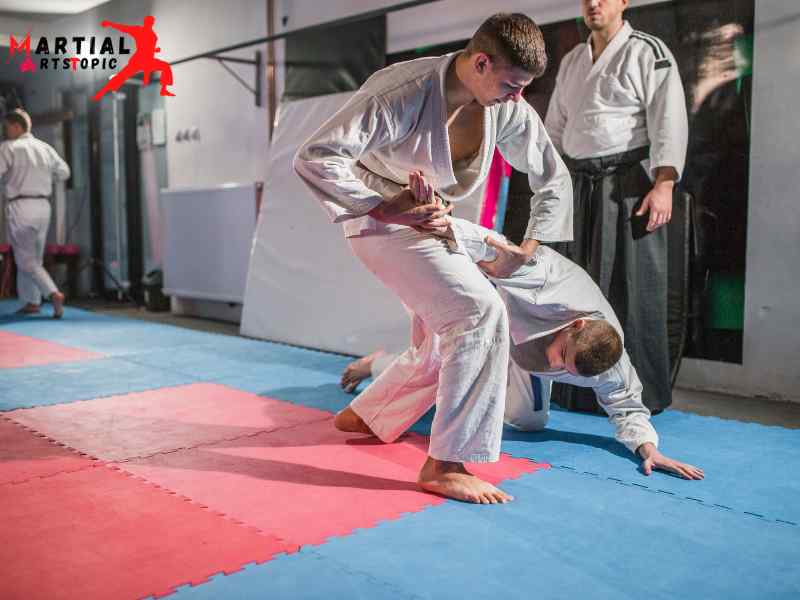
Judo Throws for Beginners: Essential Techniques to Get Started
Judo Throws for Beginners: Essential Techniques to Get Started If you’re new to the world of Judo, you may be wondering where to begin. Judo is a martial art that focuses on throws and grappling techniques to overcome your opponent. Judo throws that are perfect for beginners.
Seoi Nage (Shoulder Throw)
One of the most popular Judo throws, Seoi Nage, involves throwing your opponent over your shoulder. Start by gripping your opponent’s gi (uniform) with both hands, then quickly step forward, dropping to one knee while pulling your opponent over your shoulder. This throw requires good timing and coordination, but it can be highly effective.
Osoto Gari (Large Outer Reap)
Osoto Gari is a powerful throw that involves sweeping your opponent’s leg while simultaneously pushing them backward. Begin by stepping to the side of your opponent, hooking their leg with your own leg, then driving them off balance and down to the ground. This throw is excellent for beginners as it relies on technique rather than physical strength.
Ouchi Gari (Large Inner Reap)
Similar to Osoto Gari, Ouchi Gari focuses on sweeping your opponent’s leg. However, in this technique, you sweep the leg on the inside rather than the outside. By stepping in and hooking your opponent’s leg, you can disrupt their balance and bring them down. Ouchi Gari is a versatile throw that can be executed from various grips and positions.
Tai Otoshi (Body Drop)
Tai Otoshi is a throw that involves using your body weight to bring your opponent down. Start by gripping your opponent’s gi and stepping forward with one foot. As you do this, drop your body down while simultaneously pulling your opponent over your leg. This throw relies on timing and leverage, making it a great option for beginners.
Uki Goshi (Floating Hip)
Uki Goshi is a throw that utilizes your hip movement to throw your opponent. Start by gripping your opponent’s gi and stepping in close to them. As you do this, lift your hip and pivot, using the momentum to throw your opponent over your back. This throw requires proper hip action and timing, but can be highly effective when executed correctly.
Morote Seoi Nage (Two-Hand Shoulder Throw)

Morote Seoi Nage is a modified version of Seoi Nage that involves using both hands to throw your opponent. Begin by gripping your opponent’s gi with both hands, then drop to one knee while simultaneously pulling your opponent over your shoulder. This throw can be more powerful than Seoi Nage as it utilizes both arms.
As a beginner, it’s essential to practice these Judo throws under the guidance of a qualified instructor. They can provide you with proper technique instruction and ensure your safety during training. Remember, mastering Judo throws takes time and patience, so don’t get discouraged if you don’t get it right away.
The History and Evolution of Judo Throws
Judo Throws: The History and Evolution Judo, a martial art that originated in Japan, has gained worldwide recognition for its dynamic throwing techniques. These throws, commonly known as Judo Throws, have become integral to the sport and have evolved over time.The history and evolution of Judo Throws, shedding light on their significance and how they have shaped the sport.
The History of Judo Throws
Judo, founded by Jigoro Kano in the late 19th century, was derived from various traditional Japanese martial arts. Kano’s vision was to create a comprehensive system that would not only encompass physical techniques but also emphasize discipline, respect, and personal development. Thus, Judo was born, and with it came the birth of Judo Throws.
Ancient Japanese jujutsu techniques, which focused on using an opponent’s momentum and balance against them heavily influenced the first generation of Judo Throws. They designed these throws to efficiently incapacitate an attacker, making them an ideal self-defense tool.
As Judo gained popularity, it underwent several transformations. Kano introduced a grading system to categorize and teach various techniques, including Judo Throws. This system allowed practitioners to systematically learn and progress through a structured curriculum. With time, Judo Throws became more refined and specialized, setting the stage for the future evolution of the sport.
The Evolution of Judo Throws
In the early years of Judo, the emphasis was on powerful throws executed with maximum force. However, as the sport developed, a new concept emerged–the principle of maximum efficiency with minimum effort. This concept, known as “ju” in Japanese, became the foundation of modern Judo Throws.
Judo Throws began to incorporate biomechanical principles, making them more effective and versatile. Practitioners started to focus on timing, leverage, and proper execution rather than relying solely on brute strength. This shift in approach allowed smaller individuals to overcome larger opponents, revolutionizing the sport and making it accessible to a wider range of practitioners.
Today, they classified Judo Throws into different categories, each with its own set of techniques and characteristics. Some of the most popular Judo Throws include Osoto Gari (major outer reap), Seoi Nage (shoulder throw), and Uchimata (inner thigh throw). These throws require a combination of technique, precision, and timing to execute successfully.
The Significance of Judo Throws
Judo Throws play a crucial role in competitive Judo. They are not only used to score points but also to immobilize opponents, setting up opportunities for submissions or transitions on the ground. Judo Throws require a deep understanding of body mechanics and balance, making them a fascinating aspect of the sport.
Beyond the realm of competition, Judo Throws have practical applications in self-defense scenarios. The ability to execute a well-timed throw can neutralize an attacker and potentially save lives. Judo practitioners develop a heightened sense of awareness and the skills necessary to defend themselves effectively.
The Top 10 Judo Throws You Need to Know
Judo is a martial art that emphasizes technique and precision. It is a sport that requires strength, agility, and strategic thinking. One of the most exciting and fundamental aspects of Judo is the throws. Judo throws are not only visually captivating but also effective techniques to take down opponents.The top 10 Judo throws that every practitioner should know.
- “Seoi Nage” (Shoulder Throw): Seoi Nage is one of the most popular Judo throws. It involves gripping the opponent’s collar with one hand while wrapping your other arm around their waist. By swiftly rotating your body and using your hips, you can throw your opponent over your shoulder.
- “O Goshi” (Hip Throw): O Goshi is a powerful hip throw that uses the momentum of your hips to lift and throw your opponent. It requires a strong grip on their collar and a deep level of coordination between your upper and lower body.
- “Uchi Mata” (Inner Thigh Throw): Uchi Mata is a throw that targets the inner thigh of your opponent. By hooking your leg inside their thigh and using a sweeping motion, you can lift and throw them off balance.
- “Harai Goshi” (Sweeping Hip Throw): Harai Goshi is another hip throw that involves sweeping your opponent’s leg while rotating your hips. It requires precise timing and coordination to execute this throw effectively.
- “Tai Otoshi” (Body Drop): Tai Otoshi is a throw that involves dropping your body weight onto your opponent to take them down. It requires both speed and accuracy to perform this throw successfully.
- “Tomoe Nage” (Circle Throw): Tomoe Nage is a throw that involves falling backward and using your legs to control your opponent’s upper body. By extending your legs and using your arms for leverage, you can flip your opponent over and gain control.
- “Koshi Guruma” (Hip Wheel): Koshi Guruma is a throw that requires a firm grip on your opponent’s collar. By using your hips and rotational force, you can wheel them over your hip and onto the mat.
- “Sasae Tsurikomi Ashi” (Propping Lifting Pulling Foot Throw): Sasae Tsurikomi Ashi is a throw that involves using your foot to block your opponent’s leg while pulling their upper body forward. This technique can catch your opponent off guard and lead to a successful throw.
- “Ko Uchi Gari” (Minor Inner Reap): Ko Uchi Gari is a throw that targets your opponent’s inner leg. By quickly reaping their leg with yours, you can disrupt their balance and throw them to the ground.
- “Sumi Gaeshi” (Corner Reversal): Sumi Gaeshi is a throw that involves using your opponent’s momentum against them. By stepping to the side and rotating your body, you can flip them over your shoulder and onto the mat.
These top 10 Judo throws are essential techniques for any practitioner. Mastering these throws requires practice, patience, and a firm foundation in judo principles. Whether you are a beginner or an experienced judoka, incorporating these throws into your repertoire will enhance your skills and make you a more formidable opponent. So, go ahead, practice these judo throws, and take your martial arts journey to new heights!
How to Improve Your Judo Throws: Tips and Techniques

Judo, an ancient martial art originating from Japan, is known for its powerful and effective throwing techniques. Mastering the art of Judo throws not only requires physical strength but also technique, precision, and agility. Whether you are a beginner looking to improve your throws or an experienced Judoka seeking to refine your skills, this guide will provide you with valuable tips and techniques to enhance your judo throws and dominate your opponents on the mat.
Develop a Strong Foundation
To improve your judo throws, it is crucial to build a solid foundation. Focus on developing core strength and flexibility through exercises such as planks, squats, and yoga. Strengthening the muscles in your legs, hips, and core will provide a solid base for executing powerful throws with ease.
Perfect Your Footwork
Footwork plays a pivotal role in executing successful judo throws. Practice your footwork drills to improve your balance, mobility, and timing. Pay attention to maintaining a stable stance and positioning yourself properly in relation to your opponent. This will allow you to generate maximum power and control during your throws.
The Gripping Techniques
Grips are essential in judo throws, as they provide the leverage and control needed to execute a successful technique. Experiment with different gripping strategies, such as the collar grip, sleeve grip, or lapel grip, to find what works best for you. Remember to maintain a firm grip while staying relaxed to effectively break your opponent’s balance.
Focus on Breaking Balance
Breaking your opponent’s balance is a fundamental aspect of judo throws. By disrupting their equilibrium, you create opportunities to execute powerful throws. Utilize techniques such as kuzushi (off-balancing) to destabilize your opponent before initiating a throw. Proper timing and coordination are crucial in achieving successful balance-breaking techniques.
Master the Hip and Leg Movement:
The hip and leg movement are crucial components of judo throws. Techniques like the hip throw (O-goshi), foot sweep (Deashi Harai), and leg reap (O-soto-gari) require precise hip and leg coordination. Practice these techniques diligently, focusing on the fluidity of your movements and the transfer of power from your legs to your upper body.
Develop Timing and Speed
Timing and speed are critical when executing Judo throws. Anticipate your opponent’s movements and exploit their vulnerabilities by employing quick and explosive techniques. Practice drills that enhance your reaction time and ability to improve your ability to execute throws in real-time situations.
Adapt to Different Body Types
In Judo, you will encounter opponents of varying body types and sizes. It is essential to adapt your throwing techniques accordingly. Experiment with modifications to your throws to accommodate different body types and leverage your strengths against your opponent’s weaknesses. This adaptability will make you a well-rounded Judoka and a formidable opponent.
Practice Randori (Free Practice):
Regularly engage in Randori, which is free practice, to apply your newly acquired techniques and improve your Judo throws. Randori allows you to test your skills against different opponents, hone your reflexes, and gain invaluable experience. Embrace the challenges that Randori presents and learns from each practice session.
The Most Effective Judo Throws for Self-Defense
Judo Throws: The Ultimate Guide to Effective Self-Defense Techniques Judo, a martial art originating from Japan, has gained popularity worldwide for its effective self-defense techniques. One of the most crucial aspects of judo is its throws, which allow practitioners to immobilize and control their opponents. The most effective judo throws for self-defense, ensuring that you have the knowledge and skills needed to protect yourself in any situation.
- Osoto Gari (Major Outer Reap)Osoto Gari is a powerful throw that involves tripping your opponent backward by reaping their leg. By using your body and momentum, Osoto Gari allows you to off-balance your attacker and create an opportunity to escape or incapacitate them.
- Ouchi Gari (Major Inner Reap)Similar to Osoto Gari, Ouchi Gari is another effective throw that targets your opponent’s leg. By hooking your leg around theirs and driving them backward, you can destabilize your attacker and gain the upper hand in a self-defense situation.
- Seoi Nage (Shoulder Throw)Seoi Nage is a classic judo throw that involves lifting your opponent onto your shoulders and throwing them over your body. This throw utilizes your entire body strength and can be executed with great speed and force, making it an excellent choice for self-defense.
- Tai Otoshi (Body Drop)Tai Otoshi is a throw that involves using your body weight to off-balance your opponent and bring them down to the ground. This technique requires precise timing and coordination, but when executed correctly, it can be a highly effective self-defense move.
- Uchi Mata (Inner Thigh Throw)Uchi Mata is a powerful throw that targets your opponent’s inner thigh. By lifting and sweeping their leg, you can unbalance them and create an opportunity to gain control or escape from the situation.
- Harai Goshi (Sweeping Hip Throw)Harai Goshi is a throw that involves sweeping your opponent’s hips in a circular motion, using your hip as the primary point of contact. This technique relies on speed and timing and can be executed with great impact, making it an effective self-defense technique.
- Koshi Guruma (Hip Wheel)Koshi Guruma is a throw that involves using your hip to lift and rotate your opponent, causing them to lose their balance and fall to the ground. This technique requires coordination and strength, but when executed correctly, it can provide a significant advantage in a self-defense situation.
Unveiling the Power: The Strength and Technique Behind Judo Throws
Judo is a martial art that has been practiced for centuries, and one of its most captivating aspects is the art of throwing. Judo throws, also known as nage-waza, are an essential part of the sport and require a combination of strength, technique, and precision. In this blog post, we will explore the power behind these throws and the techniques that make them so effective.
Judo throws are not only visually stunning but also highly strategic. They allow a practitioner to quickly and efficiently disable an opponent by using their own momentum against them. The key to executing a successful throw lies in understanding the principles of balance, leverage, and timing.
Balance is crucial in Judo throws. By disrupting an opponent’s balance, you can take control of the situation and set up the perfect opportunity for a throw. I do this by utilizing a combination of footwork, grips, and body positioning to unbalance the opponent and create an opening.
Leverage is another fundamental element of Judo throws. By using an opponent’s body as a lever, a judoka can generate incredible force and effortlessly throw even a larger and stronger adversary. They achieve this by manipulating the angle and direction of the throw, maximizing the use of joints and muscles to create a mechanical advantage.
Timing is the final piece of the puzzle. Judo throws require split-second decision-making and impeccable timing. A well-timed throw can catch an opponent off guard, leaving them vulnerable and unable to defend against the force of the throw. This requires hours of practice and a deep understanding of the opponent’s movement patterns and reactions.
Now, let’s dive into some of the most popular Judo throws:
- Osoto-gari (major outer reap): This throw involves sweeping the opponent’s leg from the outside, causing them to lose balance and fall to the ground. It requires precise footwork and timing to execute effectively.
- Seoi-nage (shoulder throw): This throw involves lifting the opponent onto your back and then using your shoulder as a pivot point to throw them over your body. It requires a combination of upper body strength, timing, and technique.
- Uchi-mata (inner thigh throw): This throw involves hooking your leg around the opponent’s inner thigh and lifting them into the air before throwing them to the ground. It requires strong hip movement and precise timing to execute correctly.
- Harai-goshi (sweeping hip throw): This throw involves sweeping the opponent’s leg with your hip while maintaining control of their upper body. It requires a combination of hip strength, footwork, and timing to execute effectively.
These are just a few examples of the many Judo throws that exist. Each throw has its own unique set of techniques and challenges, but they all share the common goal of using an opponent’s momentum against them.
Judo Throws for Self-Defense: Techniques to Keep You Safe

Judo Throws for Self-Defense: Techniques to Keep You Safe In today’s unpredictable world, it’s essential to have the skills to protect yourself in case of an emergency. While there are various martial arts disciplines to choose from, Judo throws stand out as effective self-defense techniques that can keep you safe in dangerous situations.
Judo, originating from Japan, is a martial art that focuses on throwing opponents to the ground using their own momentum. These throws can be highly effective for self-defense, as they allow you to quickly incapacitate an attacker and create distance to escape.
Here, we will explore some of the most practical Judo throws for self-defense:
- Osoto Gari (Major Outer Reaping): This throw involves sweeping your opponent’s leg and taking them down by reaping their outer leg. It can be particularly effective when an assailant is charging towards you, as you use their own momentum against them.
- Ouchi Gari (Major Inner Reaping): Similar to Osoto Gari, this throw involves reaping your opponent’s inner leg. It’s a powerful technique that can destabilize your attacker, giving you the opportunity to escape or incapacitate them further.
- Seoi Nage (Shoulder Throw): Seoi Nage is a classic Judo throw that involves lifting your opponent onto your back and throwing them over your shoulder. This technique requires timing and precision, but when executed correctly, it can be devastatingly effective.
- Harai Goshi (Sweeping Hip Throw): In Harai Goshi, you use your hip to sweep your opponent off their feet and throw them to the ground. This technique relies on balance and leverage, making it an excellent choice when your attacker is larger or stronger than you.
- Uki Goshi (Floating Hip Throw): Uki Goshi is similar to Harai Goshi but involves a higher lift. By using your hip and upward momentum, you can lift your opponent off the ground and throw them over your hip. This throw is effective for quickly incapacitating an attacker.
- Tai Otoshi (Body Drop): Tai Otoshi involves dropping your body weight onto your opponent, causing them to fall forward. It’s an excellent technique to use when an assailant is pushing or grabbing you, as it uses their force against them.
- Koshi Guruma (Hip Wheel): Koshi Guruma is a throw that involves using your hip to lift and rotate your opponent, throwing them to the ground. It can be useful in close-quarters situations, allowing you to quickly neutralize an attacker.
How to Generate Maximum Force in Judo Throws
How to Generate Maximum Force in Judo Throws Judo is a martial art that emphasizes the use of efficient techniques rather than brute strength. However, when it comes to executing powerful throws, generating maximum force becomes crucial. In this blog post, we will explore the techniques and principles that will help you unleash your power in judo throws.
Develop Strong Foundation
A firm foundation is essential for generating maximum force in judo throws. This starts with building a solid base through strength training exercises that focus on your lower body, core, and grip strength. Squats, deadlifts, and kettlebell swings are excellent exercises to include in your training routine.
Perfect Your Technique
Proper technique is the key to generating power in judo throws. Focus on mastering the fundamental movements and principles of each throw. Practice your footwork, hip movement, and timing to ensure that your execution is flawless. Remember, precision and efficiency lead to maximum force.
Utilize Proper Body Mechanics
Understanding and utilizing proper body mechanics is crucial for generating maximum force. This includes maintaining a strong posture, utilizing your core muscles, and leveraging your body weight. By utilizing these mechanics, you can transfer your power efficiently from your lower body through your upper body and into your opponent.
Develop Explosive Strength
Explosive strength is essential for generating maximum force in judo throws. Incorporate exercises that target fast-twitch muscle fibers, such as plyometrics and Olympic lifts, into your training routine. These exercises will help you develop the explosive power needed to execute powerful throws.
Develop Speed and Timing
Speed and timing are essential factors in generating maximum force in judo throws. Work on improving your reaction time and developing quick hand and foot movements. This will allow you to catch your opponent off guard and execute throws with maximum force.
Focus on Grip Strength
Having a powerful grip is essential for executing powerful throws in judo. Develop your grip strength through exercises such as farmer’s walks, towel pull-ups, and grip trainers. A powerful grip will allow you to control your opponent’s movements and execute throws with maximum force.
Develop Body Awareness
Body awareness is crucial for generating maximum force in judo throws. It involves understanding your body’s position, balance, and alignment during throws. Practicing balance drills, bodyweight exercises, and proprioceptive training will help improve your body awareness, leading to more powerful throws.
Train with Resistance
Training with resistance can help you develop the strength and power needed for maximum force in judo throws. Incorporate resistance bands, weighted vests, or training partners into your training sessions. This will challenge your muscles and allow you to develop the explosive power necessary for powerful throws.
Conclusion
Judo throws are a fundamental aspect of the sport and play a crucial role in determining the outcome of a match. They require a combination of technique, timing, and strength to execute effectively. Judo throws not only showcase the skill and ability of the practitioners but also demonstrates the principles of balance, control, and leverage that are central to the sport. Whether it’s the powerful hip throw or the swift foot sweep, each throw embodies the essence of judo and its emphasis on using an opponent’s energy to gain an advantage. By mastering these throws, judokas can not only dominate their opponents in competitions but also develop discipline, self-confidence, and respect both on and off the mat. So, whether you’re a beginner or an advanced practitioner, exploring and perfecting the art of judo throws can be a rewarding and exciting journey.
